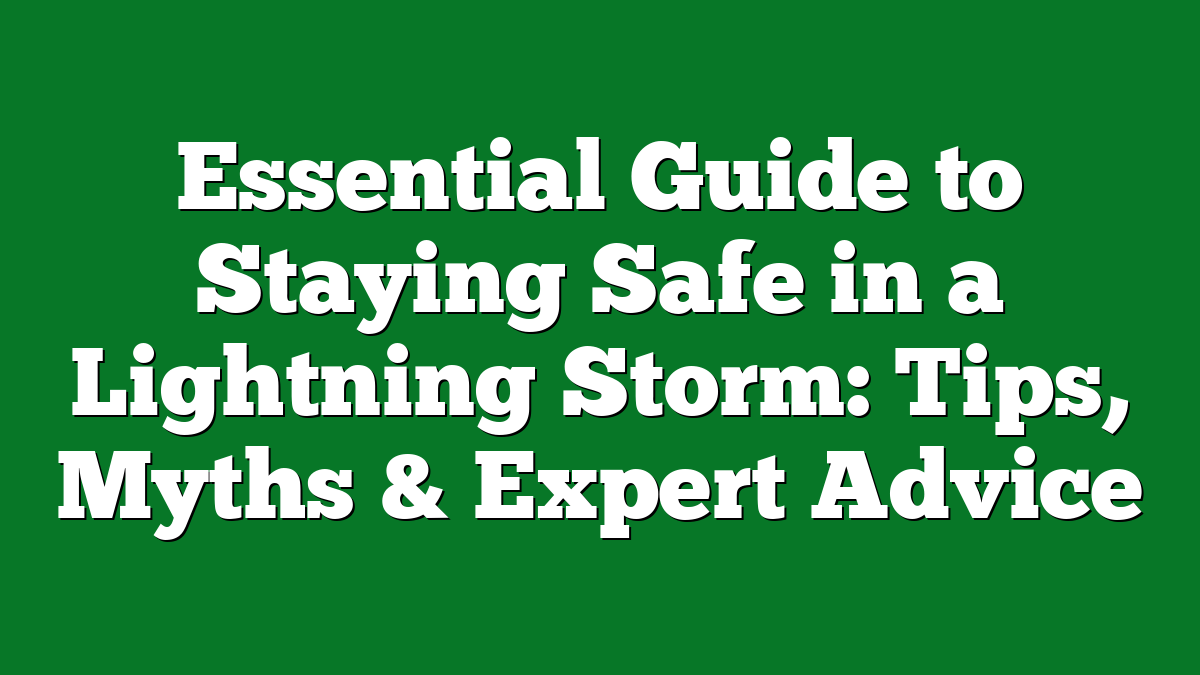When dark clouds gather and thunder rumbles, it’s easy to feel a twinge of anxiety. Lightning storms can be thrilling but they also pose serious risks. I’ve always found the power of nature both awe-inspiring and a bit frightening, especially when it comes to lightning. Understanding how to stay safe during these storms can make all the difference.
In this guide, I’ll share practical tips and insights to help you navigate the stormy weather with confidence. Whether you’re at home, out camping, or caught in the open, knowing what to do can keep you and your loved ones safe. Let’s dive into some essential safety measures that can help you weather the storm without worry.
Understanding Lightning Storms
Lightning storms pose unique risks, especially for those of us who enjoy camping and spending time outdoors. Grasping the science behind these storms and their different types helps in anticipating their dangers.
What Causes Lightning?
Lightning occurs due to energy buildup in storm clouds. I’ve learned that the process begins with the collision of ice and water droplets within clouds. These collisions create static electricity, which separates positive and negative charges. When the charge difference becomes too great, a discharge of electricity occurs, resulting in a bolt of lightning. This phenomenon can happen within a cloud, between clouds, or between a cloud and the ground. Knowing this helps me appreciate how unpredictable lightning can be, especially when I’m outside.
Types of Lightning Strikes
Lightning strikes come in different forms, each with its own impact. I’ve come across these main types:
- Intra-Cloud Lightning: This type occurs within a cloud and is the most common. It usually creates a flickering light show, which can be mesmerizing but poses no direct danger to those on the ground.
- Cloud-to-Ground Lightning: This strike happens when an electrical discharge travels between the cloud and the ground. It’s the most dangerous type, as it can strike trees, people, and structures, causing serious injury or damage.
- Cloud-to-Cloud Lightning: This occurs between two clouds. While it’s visually impressive, it doesn’t typically harm those on the ground.
- Ground-to-Cloud Lightning: This type, which rises from the ground to the clouds, is less common. It can occur from tall structures or trees and also poses risks.
Understanding these types of lightning strikes guides my actions during storms, helping me make safer choices whether I’m setting up camp or hiking.
Preparing for a Lightning Storm
Preparing for a lightning storm involves both awareness and action. Being ready can make a big difference in ensuring safety while camping or enjoying the outdoors. Here are some essential steps to take.
Assessing Weather Conditions
Assessing weather conditions starts with monitoring forecasts. Use reliable weather apps or websites to track storms in real-time. Watching for darkening skies and hearing thunder helps gauge an approaching storm. Check for alerts and notifications from local authorities. If the forecast predicts storms, plan to stay indoors or seek shelter. Understand that lightning can strike up to 10 miles away from a storm, so don’t wait until drops begin to fall.
Safety Gear and Equipment
Safety gear and equipment play a crucial role in storm preparedness. Carry a weather radio or a portable charger to stay informed during outages. Include a first-aid kit to address injuries. Pack a sturdy tent with a low profile to minimize risk, and avoid using metal poles while setting it up. Keep your shoes and sturdy clothing nearby to gear up quickly. Consider lightning-resistant outdoor gear if storms are frequent in your camping area. A good flashlight is vital for visibility anytime, especially when strong winds or rain disrupt normal conditions.
During a Lightning Storm
Staying safe during a lightning storm is crucial for anyone who loves the outdoors. I’ve spent countless nights camping, and I’ve learned valuable lessons about weathering these intense storms.
Safe Locations to Seek Shelter
Finding the right shelter during a lightning storm can make all the difference. If you’re outdoors, look for a sturdy building or a designated storm shelter. If those aren’t available, stay away from tall trees, which can attract lightning. Instead, crouch low in a ditch or low-lying area, but ensure it’s not prone to flooding. In your tent, keep a safe distance from metal stakes and rods, as these can conduct electricity. Remember, shelter in your vehicle offers protection, but don’t touch metal parts. Whenever possible, plan your camping trips around weather forecasts to know when to seek refuge.
Electrical and Fire Safety Tips
Lightning storms pose unique hazards, especially with electrical and fire safety. Unplug electronics in your campsite if time allows. Avoid using wired devices since they can attract electrical surges. If a fire’s already burning, douse it thoroughly with water. Don’t use waterlogged logs or branches for kindling once the storm hits. Keep flammable materials secured and away from lightning strikes. Finally, ensure your campsite is equipped with a first-aid kit and a weather radio to receive updates. Small steps can greatly enhance safety and preparedness during storms.
Common Myths About Lightning
Many misconceptions about lightning exist, often leading to unsafe decisions during storms. Understanding these myths helps me stay safe while enjoying camping and outdoor adventures.
Debunking Misconceptions
- Lightning Never Strikes the Same Place Twice
Lightning frequently strikes the same location multiple times, especially if that place is a tall structure, like a radio tower or a skyscraper. When I’m camping, I remember that high ground or isolated trees can be particularly dangerous.
- IT’S Safe to Wait Out the Storm in a Car
It’s often safer to stay in my car during a lightning storm since the metal frame can direct the electric current away from me, provided I don’t touch any metal surfaces inside. This is a reliable sanctuary when camping away from sturdy buildings.
- Thunder Only Follows Lightning
Thunder and lightning are part of the same process. I hear thunder because it travels slower than light. This means whenever I see lightning, it’s possible that thunder is just seconds away—time to find shelter.
- Lightning Can’t Strike the Same Person Twice
This myth is particularly dangerous. Some people, like those who are frequently outdoors or work in elevated positions, face increased risks. I take care to implement safety measures regardless of my past experiences.
Facts About Lightning Safety
- Seek Shelter Promptly
If I notice dark clouds and hear thunder, I know to seek shelter immediately. Ideally, that means finding a structure or a vehicle, as these options provide the best protection against lightning strikes.
- Avoid Water and Metal
I steer clear of bodies of water as they conduct electricity. Staying away from metal tents, bike frames, or fishing equipment during a storm minimizes my risk significantly.
- Stay Low but Safe
If no shelter is available, I crouch low to the ground in a low-lying area, keeping my feet together to minimize ground contact. This reduces the chances of ground current injury.
- Wait for Clear Signals
I wait at least 30 minutes after the last sound of thunder before leaving my shelter. Storms can be unpredictable, and this caution helps ensure that the danger has truly passed.
Conclusion
Staying safe during a lightning storm doesn’t have to be overwhelming. With the right knowledge and preparation I can confidently face stormy weather. By understanding the science behind lightning and debunking common myths I can make smarter choices that keep me out of harm’s way.
Whether I’m at home or out enjoying nature it’s crucial to have a plan in place. I’ll always remember to seek safe shelter and keep my safety gear handy. By staying informed and taking the necessary precautions I can truly enjoy my adventures without fear. So next time the skies darken and thunder rumbles I’ll be ready to embrace the storm with confidence.











